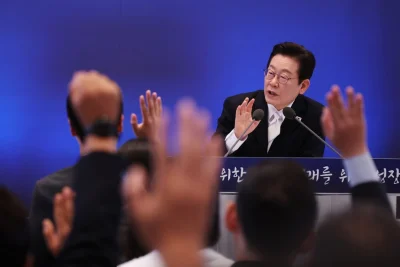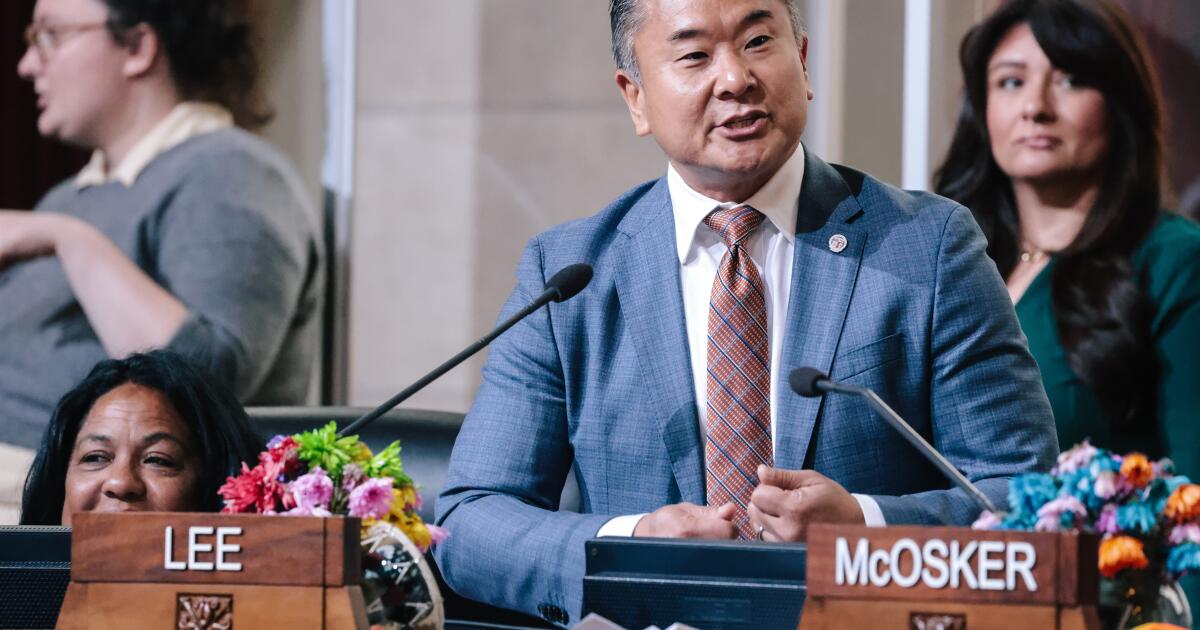L.os Angeles City Councilmember John Lee is facing a steep fine for his notorious 2017 trip to Las Vegas, with the city’s Ethics Commission saying he must pay $138,424 in a case involving pricey meals and expensive nightclub “bottle service.”
On Wednesday, the commission decided 4 to 0 that Lee, who represents the northwest San Fernando Valley, committed two counts of violating the city’s gift law and three counts of violating a law requiring that such gifts be disclosed to the public.
By a 3-1 vote, the panel found that Lee violated five additional counts of misusing his city position or helping his boss at the time — Councilmember Mitchell Englander — misuse his position. After that, the commission voted unanimously to levy the maximum financial penalty, as recommended by city ethics investigators.
The commission went much further than an administrative law judge, who, after a multiday hearing, concluded that Lee violated five of 10 counts and recommended a fine of nearly $44,000.
Commission President Manjusha Kulkarni argued for the maximum fine, saying it would discourage others from violating ethics laws. She said Lee directly benefited from his decision not to report the gifts — which came from three men who sought business with City Hall — on his economic disclosure forms.
Lee, by failing to report those gifts, gained an unfair advantage during his 2019 and 2020 election campaigns, both of which he won by small margins, Kulkarni said.
“There was a concealment effort made there in order to win those two elections,” she said.
Commissioner Aryeh Cohen voted against the five additional ethics counts, saying he wasn’t convinced that the gift information would have made a difference. Last year, after city investigators accused Lee of violating gift laws, he won reelection handily.
“Voters knew, and he won by a larger margin” than in 2019 or 2020, Cohen said. “So I don’t think that that was a misuse of a position or gaining benefit from it.”
Brian Hildreth, an attorney representing Lee, had argued for a maximum fine of $10,000. Appearing before the commission, he said city investigators incorrectly calculated the value of the gifts and failed to take into account how much Lee had actually consumed at the food and drink venues.
Lee, in a statement, vowed to keep fighting the charges, calling the case “wasteful and political.” An appeal would need to be filed in Los Angeles County Superior Court.
“Today is but one step in the process of fighting these baseless charges,” he said. “I look forward to finally having an opportunity to have this matter adjudicated in a fair and impartial setting.”
The Lee case revolves around gifts — mostly meals and alcohol but also hotel stays, transportation and $1,000 in gambling chips — provided by the three businessmen: Andy Wang, who peddled Italian cabinets, “smart home” technology and facial recognition software; architect and developer Chris Pak; and lobbyist Michael Bai.
Lee, while working as Englander’s chief of staff, flew with his boss and several others — including Wang and Bai — to Las Vegas in 2017. Englander resigned from office the following year, after being contacted by FBI agents about the trip.
In 2020, federal prosecutors accused Englander of accepting $15,000 in cash from Wang, lying to FBI agents and obstructing their investigation. He eventually pleaded guilty to a single count of providing false information to the FBI and was sentenced to 14 months in prison.
In 2023, Englander agreed to pay $79,830 to settle an Ethics Commission case focused on his own gift law violations. That same year, the commission filed a case against Lee, saying he violated the gift law not just in Vegas but also at restaurants in downtown L.A. and Koreatown.
Lee repeatedly denied the allegations and argued that the statute of limitations had run out. The commission responded by scheduling a multiday hearing, held in June before Administrative Law Judge Ji-Lan Zang.
During those proceedings, Lee said he made a good faith effort to pay his own way and, in some cases, declined to eat during meals. For example, he testified that he did not remember eating during the meetings at Yxta Cocina Mexicana and Water Grill, both in downtown L.A.
Zang, in her written report to the commission, called those denials “not credible,” saying it “strains credulity” to believe that he would join the group at those restaurants without eating any food.
During the Las Vegas trip, Lee stayed at the Aria hotel, went to Blossom restaurant and spent an evening with the group at Hakkasan Nightclub.
At Blossom, Wang ordered a dinner worth nearly $2,500 that included shark fin soup, Peking duck and Kobe beef. Lee testified over the summer that he arrived at the restaurant in time for a dessert of bird’s nest soup, tasting it and deciding he did not like it.
At Hakkasan Nightclub later that night, Wang purchased three rounds of bottle service for the group for around $8,000 apiece, while Pak purchased a fourth round for $8,418.75.
Lee said he gave Wang $300 in cash as reimbursement for his drinks, withdrawing money from an ATM. Hildreth, his attorney, told the commission that drinks were served to a large number of nightclubgoers.
“The testimony and the evidence suggests that dozens and dozens of people were joining Councilmember Lee and others,” he said.
Kulkarni, before the vote, said she was especially troubled that Lee, after being contacted by FBI agents in 2017, sent Wang a backdated check for $442 to reimburse him for some of the Vegas trip. That act on its own, she said, constituted “a very serious offense.”
“That is not a mistake that one does. That is an affirmative act,” she said.
Hildreth said his client wrote a reimbursement check right away but that it was lost, necessitating a second, backdated check. He also noted that Lee cooperated with federal law enforcement and city ethics investigators.
“He sat for two interviews with the FBI,” Hildreth said. “That’s not something that deserves a punitive penalty.”













